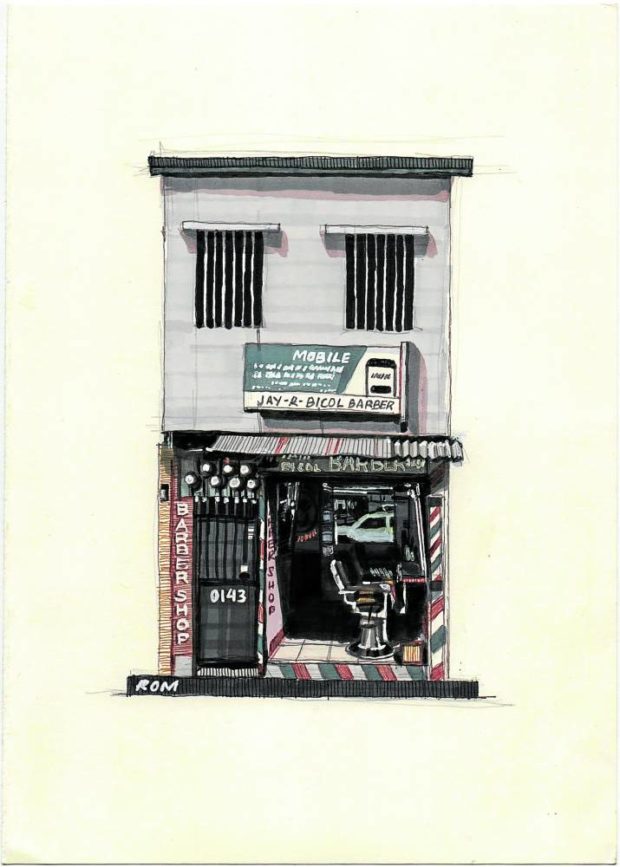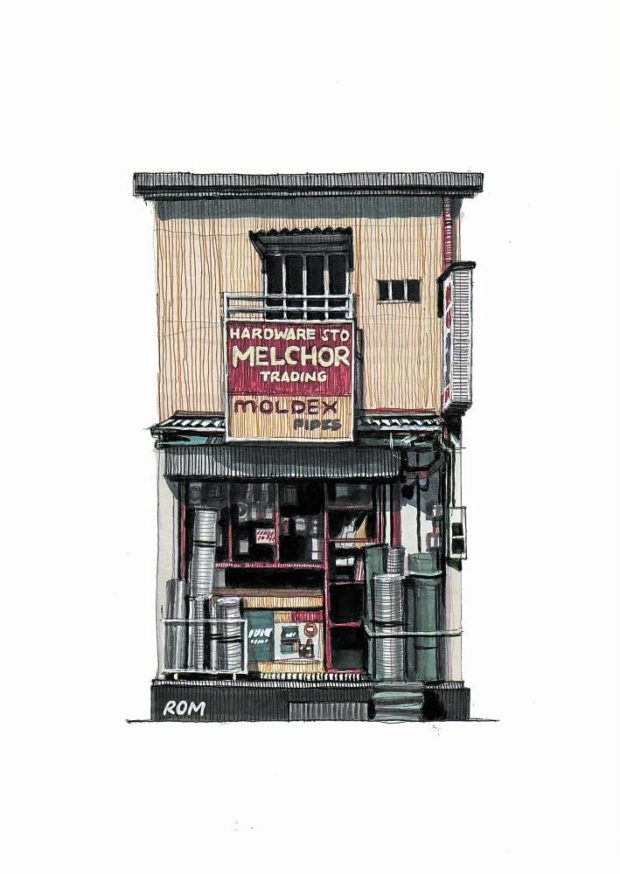Nostalgia and a young artist’s sense of home
The sun was at its zenith by the time the interview with artist Rommel Cahilo was winding down. He pointed across the narrow but busy street to where he recently purchased ingredients for tinola, a couple of stalls where they sell meat and vegetables not far from his house. Looking around, a lot of businesses are, in fact, not far from his house.
At the entrance to the alley leading to his home is a former eatery that now sells ukay-ukay and school supplies. It was one of his earlier subjects in his now viral series of store facades.
His neighborhood is host to a long, busy stretch of businesses of all shapes and sizes. There’s a clothes shop in front of a hardware store beside a novelty shop across a pharmacy. Wet and dry goods live side by side in the bustling talipapa that’s also dotted with sari-sari (convenience) stores where the Filipino culture of tingi (piecemeal) is alive and thriving.
Cahilo has lived all his 27 years in the packed residential and commercial area. He did his first storefront art in 2019 but it wasn’t until 2020 when he contracted COVID and had to resign from his job that he started observing them more closely and drawing them in earnest.
His doctor recommended that he take daily morning walks to strengthen his heart and lungs, so he started seeing these houses and stores regularly.“I wanted to document my neighborhood through drawing since I’m always seeing it,” said Cahilo, an architect by profession—a giveaway are his clean lines, attention to detail and focus on structures.
Unless extremely coddled, anybody living in the Philippines is bound to encounter these familiar images: the eponymous store signs, the awning made of corrugated sheets, the sachet garlands cascading from the ceiling like wisteria, the DIY-ed electric fly swatter spinning lazily above hunks of fresh meat.
Nostalgia
Instead of the loud reality, you feel a sense of hushed stillness when looking at Cahilo’s extremely detailed artwork in muted hues. Everything seems to be on pause, leaving you in quiet remembrance of some distant idyllic scene. This gentle surge of nostalgia is what Cahilo wants to convey with his storefront art series.
As he talked about what started it all—a supporting element to his illustration of his mother’s sinigang, depicting the meat shop where they bought the ingredients—he glowed with shy fondness as he described how he had tried to capture the essence of the dish, down to the use of their handleless pot.
While his pieces may feel reminiscent of quaint Japanese storefront art, he was actually inspired by artists Chris Dove and Mark Poulier who also use pens and markers for their architectural illustrations.

Cahilo uses ballpoint markers and alcohol-based markers on practically any type of paper (vellum paper for commissions), but he likes his Limelight sketchbooks because of the feel when he puts pen to paper.
“I look for reference na maganda yung tapon ng shadow,” Cahilo said, adding that the best lighting for him is at 10 a.m. or 3 p.m. Once he decides on a subject, he does a preliminary sketch with pencil then traces it using a pen.
“I don’t do full shade for the ballpoint pen, and instead just put lines. I think that’s what gives style to my illustrations,” he added.
He then puts in the base colors and adds as many details as he can but limiting his palette to earth tones, mostly browns and grays, which has become his signature.
“My favorite part of the process is putting in the shadows using different shades of dark gray markers to create depth,” he said.
Urban landscapes
For his “Kabahayan” series showing a bird’s-eye view of urban landscapes, he mostly uses Google image search to find references. But it has also become his habit to take photos of possible subjects whenever he’s out and about. During a site visit to Baguio, their hotel room had a striking view which he ended up illustrating later.
Other times, he finds himself going to places just to check out the views. “I take pictures of stores to capture the structures,” he said.
As an architect, it has become second nature to him to notice and inspect his premises. “When I enter a building, I’m always looking up at the ceiling or the walls. I’m fascinated with the materials, shape, build and uniqueness of establishments.”
Having drawn quite a number of storefronts, he has observed that structures vary depending on the type of business. A sari-sari store looks very different from a vulcanizing shop. But what these have in common are the materials they use.

“Since we live in a tropical country, they use a lot of lightweight materials. In the aftermath of a typhoon, they’re easier to replace unlike glass. The stores are often mixed-use with the store on street level and the living area on the upper floor.
Aside from architectural illustrations and dishes, he also does realistic portraits but enjoys doing store facades the most.“With portraits, there’s pressure to get the look of subject right but with store facades, as long as you capture the details of the establishment, it’s okay already,” Cahilo said. Commissioned work
He often gets commissioned to illustrate significant places and ancestral homes. “I’m honored because I get to document these structures for them.”Now that he has gone back to work, however, he can only draw on weekends. He works on each element in one sitting, sometimes taking an entire half-day. So he usually needs at least two weeks to a month to work on his commissions.
But he’s grateful for the extra work, having realized that during these hard times, a single source of income may no longer be enough.
He usually posts his works on Instagram (@rcdraws) and Twitter (@rommeldrawlines). Not so much on his Facebook account, though.
“Parang nahihiya ako,” Cahilo said, explaining that his Facebook contacts are mostly people he knows personally. There was also an incident where he was called “mayabang” (braggart) for posting his works.

Engagement on his art blew up unexpectedly when a fellow artist with significantly more followers started retweeting him, proving that artists supporting artists helps. “Kaya nga sabi ko sa humihingi ng advice, post your work.”
One time, one of their managers showed him a screenshot of his Twitter page, asking if it was him. He thought he was in trouble, but it turned out that one of the bosses from Shell wanted to commission an artwork from him.
Dealing with critics
But as with anything online, the good is usually mixed in with the bad. However few and isolated, he can’t help agonizing over comments about his work being poverty porn.
“I feel conscious about comments like that but then I remember, I live here,” he said, adding that a lot of commenters also defend his art.
He also pointed out that the owners of the stores he draws were unlikely to be destitute. “Iniisip ko nga, mas mayayaman pa yung mga may-ari ng mga yan kasi business owners sila.”Cahilo had a joint exhibition with furniture designer Paco Pili at Space Encounters Gallery in Ortigas Center where he displayed his collection of store facades and urban landscapes from his neighborhood and places he had visited. “It was a nice and happy experience given that it’s my first legit exhibit where I can showcase my current art style.”
Toy collector
As an architect, one project he was involved in from start to finish was the McDonald’s in Bonifacio Global City. Oddly enough, it was the toys from quick-service restaurants like this that spurred his other interest besides art and architecture.

Whenever he did well in school, he would ask his father to buy a toy for him at McDonald’s. When he began earning himself, his collection expanded to include Funko Pops and McFarlane action figures, occupying much space in their rented single-room apartment.
“Naiinis na sila (his parents) sa dami. Sabi nga ni Mama, ilaga ko na raw,” he said, laughing.
Theirs is a warm, vibrant community. At the end of the interview, the titas from the beauty parlor across the eskinita teased Cahilo to show off his artwork.For all his exposure to different lifestyles of different people in his job, he still prefers the liveliness of his Pasig neighborhood. “Yung lugar na hindi masyadong matao, naiisip ko ‘pag ako nakatira dun, parang hindi ko kaya. Gusto ko maingay na environment. ‘Pag Pasko, masaya and maraming nabibiling pagkain.”
He just can’t imagine living anywhere else. INQ
For all the latest Lifestyle News Click Here
For the latest news and updates, follow us on Google News.

